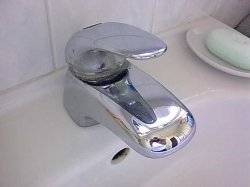Like many people in the UK, we dont have a hot water tank any more. If you have one of the new type "combi" boilers your water is heated instantaneously and therefore no need for a tank. I use the kitchen mixer tap, get it to the right temp for the tank with a balance of warm and cold, then use a hose water changer which is made like a python, with one difference: the waste water goes on my garden to water the plants. I made the water changer myself which works like a python type. I add the dechlor straight to the tank, I use prime and the dose is a compromise between the stated dose for the whole tank and the dose for the 25% replaced. I use this on two tanks and I turn the filters off when water changing. As far as I know I havent wiped out my good bacteria and I havent had any problems since adopting this method. I have a bad back and cant be doing with carrying buckets, nor do I want to do the huge bucket with pump thing either, but I would do this if I felt there was a problem to the fish.
I started using the hosepipe method after visiting a couple of local breeders with fish houses and watching them.


 ) Thanks for the link to that tap adaptor, now I can properly persuade my dad that this is a good idea!
) Thanks for the link to that tap adaptor, now I can properly persuade my dad that this is a good idea!